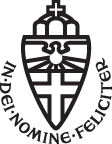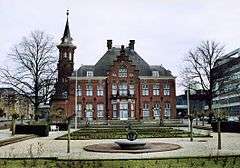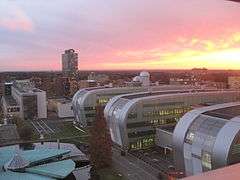Radboud University Nijmegen
| Radboud Universiteit Nijmegen | |
 | |
| Latin: Universitas Radbodiana Noviomagensis | |
| Motto | In Dei nomine feliciter |
|---|---|
Motto in English | Happily in God's name |
| Type | private (publicly funded) |
| Established | 17 October 1923 |
| Affiliation | Roman Catholic[1][2] |
| Rector | Han van Krieken |
Academic staff | 2,915[3] |
| Students | 19,904[3] |
| Location | Nijmegen, Netherlands |
| Campus | Urban |
| Colors |
[Carmine Red[4]] White |
| Affiliations |
EUA FIUC/FUCE (IFCU) |
| Website |
www |
Radboud University Nijmegen (abbreviated as RU, Dutch: Radboud Universiteit Nijmegen, formerly Katholieke Universiteit Nijmegen) is a public university with a strong focus on research located in Nijmegen, the Netherlands. It was established on 17 October 1923 and is situated in the oldest city of the Netherlands. The RU has seven faculties and enrolls over 19,900 students. It was internationally ranked 156th by the QS World University Rankings.[5]
History

The first Nijmegen University was founded in 1655 and terminated around 1680. The Radboud University Nijmegen was established in 1923 as the Katholieke Universiteit Nijmegen (Catholic University of Nijmegen) and started out with 27 professors and 189 students. It was founded because the Roman Catholic community wanted its own university. At the time, Roman Catholics in the Netherlands were disadvantaged and occupied almost no higher posts in government. After fierce competition with the cities of Den Bosch, Tilburg, The Hague, and Maastricht, Nijmegen was chosen to house the university. The subsequent Second World War hit the university hard. Many prominent members were lost, among them professors Robert Regout and Titus Brandsma. They were deported to Dachau concentration camp. In 1943, rector Hermesdorf refused to cooperate with the Germans. On 22 February 1944, the university lost many buildings in a bombardment. Classes resumed in March 1945. Since then, student numbers rose steadily from 3,000 in 1960 to 15,000 in 1980.
In 2004, the university changed its name to Radboud University Nijmegen, after Saint Radboud of Utrecht, a bishop who lived around 900.[6]
Campus
The university's medical department is linked to the Radboud University Medical Center, a large teaching hospital located on the Heyendaal campus along with the other university buildings such as the Huygensgebouw which contains the Natural Sciences. The Erasmus Tower and the Erasmusgebouw which contain the Faculty of Arts are situated at the south end of the campus next to the sports centre (USC). Recent building projects included new on-campus residence halls, the sports centre and several science buildings. The new Grotiusgebouw is recently built and will offer more room to the Faculty of Law. The university campus is located next to Heyendaal train station. Frequent shuttle buses connect the university to Nijmegen Central Station and the city centre.
Radboud University is noted for its green campus, often listed among the most attractive in the Netherlands.[7]
Academics
Education

Radboud University has seven faculties and enrols over 19.900 students in 112 study programs (37 bachelor's and 75 master's programs).[8]
As of September 2013, the university offers 36 international master’s programs taught in English and several more taught in Dutch. There are two bachelor's programs taught fully in English: International Economics & Business and International Business Administration. All other bachelors are in Dutch, although most of the required literature is in English. Some exams, papers and even classes may be in English as well, despite the programs being Dutch-taught. All master’s programs have been internationally accredited by the Accreditation Organization of the Netherlands and Flanders (NVAO).
International Master's programs
All English-taught Master’s programmes are research-based programmes. They are taught within the Faculties of Arts, Law, Social Sciences, Medical Sciences, Sciences and Philosophy, Theology and Religious Studies, besides the Interfaculty Research school and the Nijmegen School of Management.[9]
(Master's in italic are specialisations)
|
|
Research
Radboud University is home to several research institutions, including the Institute for Management Research, NanoLab Nijmegen, the Donders Institute for Brain, Cognition and Behaviour, the High Field Magnet Laboratory and the FELIX laboratory. Faculty members Anne Cutler (1999), Henk Barendregt (2002), Peter Hagoort (2005), Theo Rasing (2008), Heino Falcke (2011), Mike Jetten (2012), Ieke Moerdijk (2012), and Mikhail Katsnelson (2013) won the Spinoza Prize. Visiting professor Sir Andre Geim and former Ph.D. student Sir Konstantin Novoselov were awarded the 2010 Nobel Prize in Physics.
University ranking
The QS World University Rankings ranked the university 177th in the world in 2015.[10] The university scored 45th in a 2012 ranking of European research universities.[nb 1]
In 2016, the Times Higher Education World University Rankings put the university in 125th place worldwide.[12]
| University rankings | |
|---|---|
| Global | |
| ARWU[13] | 118 (2016) |
| Times[14] | 125 (2015) |
| QS[15] | 177 (2015) |
| Europe | |
| Times[16] | 127 |
Radboud Excellence Initiative
The Radboud Excellence Initiative was created with the dual purposes of attracting talents from every academic field to Radboud University while strengthening international bonds between universities worldwide. The initiative is a joint enterprise of both Radboud University and Radboud University Medical Center. It provides two routes by which a researcher may come to Radboud University. Promising researchers who have completed their doctorate between two and twelve years at the point of nomination may be nominated for a fellowship whereas those researchers who are more established in their discipline may be nominated for a professorship.[17]
Once selected, fellows may come to Radboud University to undertake research for a maximum of two years. Professors may come to Radboud University for a maximum period of six months.[18]
Coat of arms
The coat of arms was designed at the time of the founding of the university by the goldsmith workshop of the Brom family in Utrecht. The lower part is the coat of arms of the Catholic Church in the Netherlands. The dove is the symbol of the Holy Spirit. The shield is surmounted by the crown of Charlemagne. Underneath is the motto "In Dei Nomine Feliciter."[19]
Notable alumni

- Dries van Agt, 1955 (LLM), former Prime Minister of the Netherlands
- Louis Beel, 1928 (LLM), former Prime Minister of the Netherlands
- Jo Cals, 1940 (LLM), former Prime Minister of the Netherlands
- Wim Crusio, 1984 (PhD), neurobehavioural geneticist
- Jos Engelen, 1973, physicist
- Thom de Graaf, 1981 (LLM), former mayor of Nijmegen
- Agnes Kant, 1989 (MSc), 1997 (PhD), former leader of the Socialist Party
- Björn Kuipers, 2001 (Msc), football referee
- Louis van de Laar, 1921, state secretary and mayor of Bergen op Zoom
- Jos van der Lans, 1981 (MA), former member of the House of Representatives
- Gerd Leers, 1976 (MSc), former mayor of Maastricht, former Minister for Immigration and Asylum Affairs
- Victor Marijnen, 1941 (LLM), former Prime Minister of the Netherlands
- Hans van Mierlo, 1960 (LLM), former Minister of Foreign Affairs
- Henri Nouwen, 1964, Catholic priest and writer
- Sir Konstantin Novoselov (PhD), awarded 2010 Nobel Prize in Physics
- Louis Reijtenbagh, 1975, Chief Executive Officer of The Plaza Group
- Frans Timmermans, 1985 (MA,) Dutch politician and diplomat who currently serves as the First Vice-President of the European Commission and the European Commissioner for the portfolio of Better Regulation, Inter-Institutional Relations, Rule of Law and Charter of Fundamental Rights in the Juncker Commission.
- Rita Verdonk, 1983 (MA), former Minister for Immigration and Asylum Affairs, former member of the House of Representatives
- Frans de Waal, 1970, biologist and primatologist known for his work on the behavior and social intelligence of primates.
Notable faculty
- Hans van Abeelen, first Dutch behaviour geneticist
- Titus Brandsma, co-founder, Nazi opponent killed in Dachau concentration camp
- Catharina Halkes, first feminist theologian to be a professor in the Netherlands
- Renate Loll, physicist
- Jos van der Meer, professor of general internal medicine
- Ieke Moerdijk, mathematician
- Cristina Pumplun, missionary vicar of the Westerkerk, Amsterdam
- Kees Versteegh, professor emeritus of Middle Eastern studies, also alumnus
- Jan van der Watt, expert in Johannine literature, General editor of Review of Biblical Literature
See also
- Hogeschool van Arnhem en Nijmegen, a University of Applied Sciences located in Nijmegen and Arnhem.
- List of early modern universities in Europe
- N.S.V. Carolus Magnus[20]
Notes
References
- ↑ Een bijzondere universiteit
- ↑ "Other networks - International Office English". ru.nl.
- 1 2 Topuniversities.com profile
- ↑ http://www.ru.nl/huisstijl-en/basic-elements/colour/
- ↑ "All Study Destinations". Top Universities. Retrieved 2013-07-21.
- ↑ History of the Radboud University Nijmegen
- ↑ "Facilities on the campus - Working at Radboud University". Ru.nl. Retrieved 2013-07-21.
- ↑
- ↑ Overview of Master's programmes and specialisations
- ↑ "QS World University Rankings 2015 Results".
- ↑ [url=http://www.researchranking.org/?action=ranking title=European Research Ranking 2012]
- ↑ "World University Rankings 2015-2016". The Times Higher Education. Retrieved 6 September 2016.
- ↑ "Academic Ranking of World Universities: Global". Institute of Higher Education, Shanghai Jiao Tong University. 2016. Retrieved September 8, 2016.
- ↑ "World University Rankings 2016-2017". Times Higher Education. 2015. Retrieved October 22, 2016.
- ↑ "QS World University Rankings 2016/17". Quacquarelli Symonds Limited. 2016. Retrieved September 8, 2016.
- ↑ "Best universities in Europe 2017". The Times Higher Education. 2016. Retrieved October 22, 2016.
- ↑ "What is the Radboud Excellence Initiative?". Radboud University Nijmegen. Retrieved 2015-03-17.
- ↑ "Radboud Excellence Initiative". Radboud University Nijmegen. Retrieved 2015-03-17.
- ↑ Judith van Beukering (red.) 80 jaar KU Nijmegen - 80 objecten. Tachtig jaar Katholieke Universiteit Nijmegen in voorwerpen van wetenschap, geschiedenis en kunst (Nijmegen 2003) 15.
- ↑ https://www.carolusmagnus.nl/home
External links
| Wikimedia Commons has media related to Radboud University Nijmegen. |